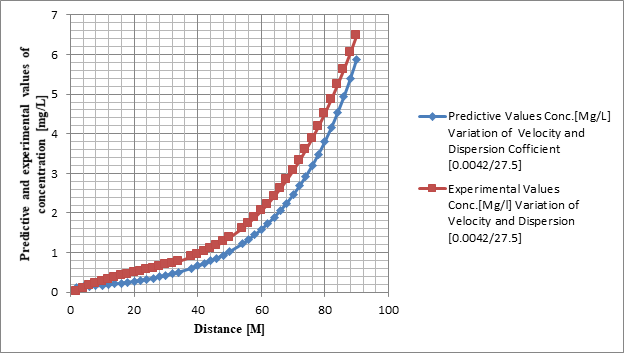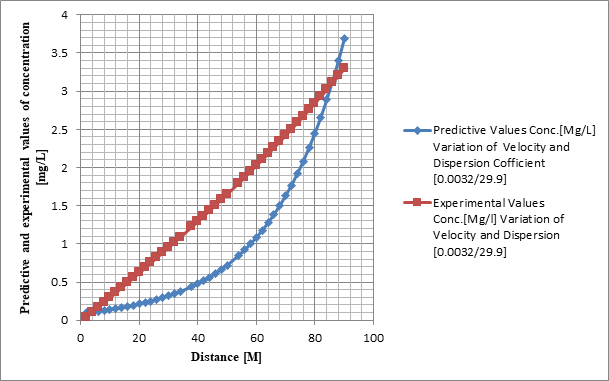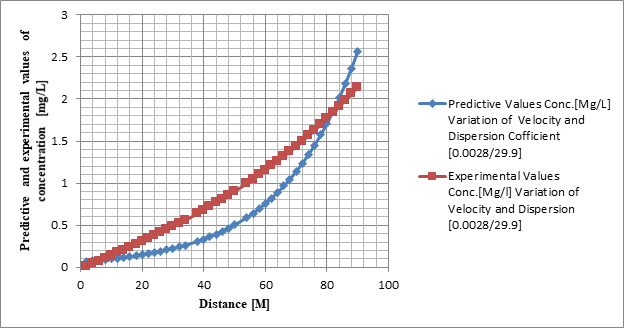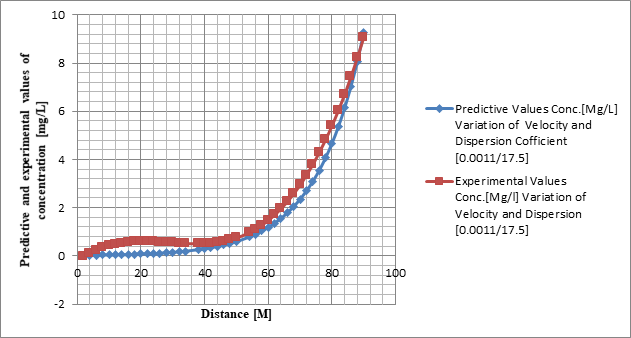MOJ
eISSN: 2576-4519


Research Article Volume 7 Issue 1
1Department of Civil Engineering, College of Engineering, Gregory University, Nigeria
2Rivers State University Nkpolu-Oroworukwo, Department of Civil Engineering, Faculty of Engineering, Nigeria
Correspondence: Eluozo Solomon, Department of Civil Engineering, College of Engineering, Gregory University, Uturu, Nigeria
Received: May 29, 2023 | Published: June 7, 2023
Citation: Eluozo SN, Arimieari LW. Modeling the transport of fecal coliform in ntanwaogba creek, influenced by variations in micronutrient deposition, velocity and dispersion coefficient. MOJ App Bio Biomech. 2023;7(1):64-70. DOI: 10.15406/mojabb.2023.07.00176
The study of Micronutrients in Ntanwaogba Creek were thoroughly carried out to monitor its rates of deposition at different numerous discharge location sites in the study environment, this was imperative because the rates of biological waste discharge at regular interval, based on this factor, it was necessary to conduct a comprehensive investigation of their rate of concentration at different station point of discharge. This implies that the rate of dispersions from the contaminant influenced constant discharge of waste in the creek, and based on these factors, it was determined that such comprehensive research was required. Micronutrients act as a substrate for microbial growth, but the speed at which they are injected into the rill affects how quickly they move through the system. In order to determine the effects of these two parameters on the migration rate of faecal coliform at different point sources of discharge, the study observed different growth rate at different station point in the study location. This observed condition indicates that the pollutants had a range of development speeds, including both slow and fast, which was enabled by these considerations. The system discovered that lower velocities have an effect on velocity rates with higher concentrations, and that accumulation with micronutrients increased their concentration. However, the concentration rates varied depending on the dominant characteristics of the transport under pressure at various points of discharge. In the simulation, these two parameters were used to determine the various pressure rates at different station points. Unquestionably, the study has depicted the effects of these two parameters' pressures on the movement of faecal coliform in a range of figures that correspond to the several point sources of discharge looked at. The speeds recorded at various station locations represented the pressure rates at various rates of concentration in the research environment. It has established the scope of the influence of rill flow velocity and the variance in micronutrient deposition at various point sources. On the basis of model simulation prediction results, also, the dispersions at various point sources were evaluated. Both parameters showed correlations for the best fits when the predicted and experimental values were compared for model validation.
Keywords: modeling, transport, fecal coliform, micronutrients and dispersion coefficient
Many studies have shown that water-borne infections are extremely dangerous to human health. These facts make it clear that, if pollution rates are not controlled, there will always be significant hazards to the overall health of the ecosystem. Total Maximum Daily Load (TMDL) implementation costs were assessed by experts, and they range from $0.9 to $4.3 billion annually.1,2 The main factor causing stream impairments is pathogen influxes from land-based agricultural activities.2,3 Controlling pathogen contamination caused by cattle, meantime, is a difficult task. Riparian buffers can be fenced off to prevent pathogen contamination; however it is not apparent how broad the buffers need to be to be effective in preventing pathogen contamination of stream water.4 The research that has thoroughly evaluated studies in this field has elaborated on the pathogen contamination of stream water 4–8 (Jamieson. More research has concentrated on understanding pathogen transmission in stream water using mathematical models.5,6,9,10 Also, the principal source of drinking water is typically a surface reservoir, indicating that these bodies of surface water are frequently subjected to pathogen pollution.9,11–13 There has been a considerable improvement in knowledge of water quality and water treatment for pathogen pollution in industrialized nations because specialists tracked the occurrences of 26 water-borne illnesses through public water sources, which were done by experts.12–21 Also, the inflow of contaminated stream water into lakes and reservoirs during the rainy seasons might result in a significant rise in pathogen rates.4,22–24 For purposes of measuring the quantity of pathogen uptake from torrents running into lakes and reservoirs during wet seasons it also involved monitoring pathogen movement including its dispersion.2,3,25
1
Nomenclatures
C = Concentration
B = Micronutrients
K = Dispersions. Velocity of flow
A= Fluid Density
X = Distance
Multiplying the equation through by , we have:
2
Let 3
Then Equation (2), we have:
4
5
6
7
Differentiate 2nd term on the left hand side of (6) with respect to x, we have
8
9
10
Applying separation of variables, by dividing through by C(x) and cross multiply by dx, gives:
11
12
13
14
15
16
17
Taking exponent of the both side of the equation
18
19
The water samples were taken sequentially according to the requirements set forth at various places. These samples were obtained at various locations, which resulted in fluctuations at various distances, resulting in variable faecal coliform concentrations, and the experimental results were compared. Using the conventional procedure for the experiment at several samples at various stations, a typical laboratory experiment was carried out to track faecal coliform.
(Table 1-6)(Figure 1-6) shows how the major influencing factors in the research environment affect the migration rate of faecal coliform. The variance of the contaminant's exponential growth rate in terms of quick and slow growth in relation to increase in distance was depicted in the figures. However, during the transport system's exponential phase. The observed fluctuations are primarily related to the pace of micronutrient depositions, including dispersion from the pollutant at several station locations, where the starting concentrations are recorded. The growth rate's behaviour did exhibit some degree of variability. Such a condition shows that the concentration change rate at different study locations was determined by the micronutrient's function as a substrate for any bacterium. The study looked at these pressures from transport and the impact that condition had on the flow dynamics that pushed the microorganisms at different station points of discharge. The many types of micronutrient depositions that have been seen in the rill and the fluctuations in those depositions as a whole have affected the growth rate of faecal coliform in the study region, as shown in graphical representation in all of the figures. The behaviour of faecal coliforms was monitored through the use of modeling and simulation by examining the variable effect of contaminant movement at distinct station points of discharge. The experimental and prediction values of each created figure expressed best fit correlations.
|
Distance [x] |
Predictive values conc.[Mg/L] variation of velocity and dispersion coefficient [0.0042/27.5] |
Experimental values conc.[Mg/l] variation of velocity and dispersion [0.0042/27.5] |
|
|
2 |
0.126042926 |
0.03112 |
|
|
4 |
0.137548218 |
0.10196 |
|
|
6 |
0.150103721 |
0.16624 |
|
|
8 |
0.1638053 |
0.22468 |
|
|
10 |
0.17875757 |
0.278 |
|
|
12 |
0.195074694 |
0.32692 |
|
|
14 |
0.212881257 |
0.37216 |
|
|
16 |
0.232313216 |
0.41444 |
|
|
18 |
0.253518939 |
0.45448 |
|
|
20 |
0.276660336 |
0.493 |
|
|
22 |
0.301914097 |
0.53072 |
|
|
24 |
0.32947304 |
0.56836 |
|
|
26 |
0.359547584 |
0.60664 |
|
|
28 |
0.392367355 |
0.64628 |
|
|
30 |
0.428182938 |
0.688 |
|
|
32 |
0.467267795 |
0.73252 |
|
|
34 |
0.509920346 |
0.78056 |
|
|
38 |
0.607260908 |
0.89008 |
|
|
40 |
0.662692134 |
0.953 |
|
|
42 |
0.723183165 |
1.02232 |
|
|
44 |
0.789195861 |
1.09876 |
|
|
46 |
0.861234246 |
1.18304 |
|
|
48 |
0.939848348 |
1.27588 |
|
|
50 |
1.025638403 |
1.378 |
|
|
54 |
1.221426272 |
1.61296 |
|
|
56 |
1.332918969 |
1.74724 |
|
|
58 |
1.454588803 |
1.89368 |
|
|
60 |
1.587364749 |
2.053 |
|
|
62 |
1.732260583 |
2.22592 |
|
|
64 |
1.890382616 |
2.41316 |
|
|
66 |
2.062938146 |
2.61544 |
|
|
68 |
2.251244672 |
2.83348 |
|
|
70 |
2.456739959 |
3.068 |
|
|
72 |
2.680993007 |
3.31972 |
|
|
74 |
2.925716041 |
3.58936 |
|
|
76 |
3.192777575 |
3.87764 |
|
|
78 |
3.484216684 |
4.18528 |
|
|
80 |
3.802258571 |
4.513 |
|
|
82 |
4.149331558 |
4.86152 |
|
|
84 |
4.528085626 |
5.23156 |
|
|
86 |
4.941412646 |
5.62384 |
|
|
88 |
5.392468463 |
6.03908 |
|
|
90 |
5.884696991 |
6.478 |
|
Table 1 Shows the model's Prediction and Experimental Values for Faecal Coliform Concentrations at Various Distances
|
Distance [x] |
Predictive values conc.[Mg/L] variation of velocity and dispersion coefficient [0.0032/29.9] |
Experimental values conc.[Mg/l] variation of velocity and dispersion [0.0032/29.9] |
|
2 |
0.102408622 |
0.0387048 |
|
4 |
0.111096671 |
0.1027384 |
|
6 |
0.12052179 |
0.1668296 |
|
8 |
0.130746508 |
0.2310072 |
|
10 |
0.141838662 |
0.2953 |
|
12 |
0.153871841 |
0.3597368 |
|
14 |
0.166925881 |
0.4243464 |
|
16 |
0.181087387 |
0.4891576 |
|
18 |
0.196450315 |
0.5541992 |
|
20 |
0.213116588 |
0.6195 |
|
22 |
0.23119678 |
0.6850888 |
|
24 |
0.250810842 |
0.7509944 |
|
26 |
0.272088905 |
0.8172456 |
|
28 |
0.295172137 |
0.8838712 |
|
30 |
0.320213683 |
0.9509 |
|
32 |
0.34737968 |
1.0183608 |
|
34 |
0.376850362 |
1.0862824 |
|
38 |
0.443504458 |
1.2236232 |
|
40 |
0.481130086 |
1.2931 |
|
42 |
0.521947764 |
1.3631528 |
|
44 |
0.566228295 |
1.4338104 |
|
46 |
0.614265457 |
1.5051016 |
|
48 |
0.666377952 |
1.5770552 |
|
50 |
0.72291152 |
1.6497 |
|
54 |
0.850773977 |
1.7971784 |
|
56 |
0.922951168 |
1.8720696 |
|
58 |
1.001251662 |
1.9477672 |
|
60 |
1.086194941 |
2.0243 |
|
62 |
1.178344562 |
2.1016968 |
|
64 |
1.278311889 |
2.1799864 |
|
66 |
1.386760152 |
2.2591976 |
|
68 |
1.504408852 |
2.3393592 |
|
70 |
1.632038525 |
2.4205 |
|
72 |
1.770495928 |
2.5026488 |
|
74 |
1.920699654 |
2.5858344 |
|
76 |
2.083646229 |
2.6700856 |
|
78 |
2.260416716 |
2.7554312 |
|
80 |
2.452183898 |
2.8419 |
|
82 |
2.66022005 |
2.9295208 |
|
84 |
2.885905385 |
3.0183224 |
|
86 |
3.130737206 |
3.1083336 |
|
88 |
3.396339848 |
3.1995832 |
|
90 |
3.684475446 |
3.2921 |
Table 2 Model Prediction and Experimental Values on Fecal Coliform Concentration at Various Distances
|
Distance [x] |
Predictive values conc.[Mg/L] variation of velocity and dispersion coefficient [0.0028/29.9] |
Experimental values conc.[Mg/l] variation of velocity and dispersion [0.0028/29.9] |
|
2 |
0.071382281 |
0.00900792 |
|
4 |
0.077438146 |
0.04106336 |
|
6 |
0.084007773 |
0.07321384 |
|
8 |
0.091134748 |
0.10550688 |
|
10 |
0.098866355 |
0.13799 |
|
12 |
0.107253889 |
0.17071072 |
|
14 |
0.116352997 |
0.20371656 |
|
16 |
0.126224047 |
0.23705504 |
|
18 |
0.136932529 |
0.27077368 |
|
20 |
0.148549486 |
0.30492 |
|
22 |
0.161151993 |
0.33954152 |
|
24 |
0.174823659 |
0.37468576 |
|
26 |
0.18965519 |
0.41040024 |
|
28 |
0.205744985 |
0.44673248 |
|
30 |
0.223199791 |
0.48373 |
|
32 |
0.242135413 |
0.52144032 |
|
34 |
0.262677477 |
0.55991096 |
|
38 |
0.309137641 |
0.63932328 |
|
40 |
0.33536398 |
0.68036 |
|
42 |
0.363815285 |
0.72234712 |
|
44 |
0.394680316 |
0.76533216 |
|
46 |
0.428163846 |
0.80936264 |
|
48 |
0.464488022 |
0.85448608 |
|
50 |
0.503893835 |
0.90075 |
|
54 |
0.593018302 |
0.99688936 |
|
56 |
0.643328251 |
1.04685984 |
|
58 |
0.697906349 |
1.09816088 |
|
60 |
0.757114694 |
1.15084 |
|
62 |
0.821346104 |
1.20494472 |
|
64 |
0.891026719 |
1.26052256 |
|
66 |
0.966618835 |
1.31762104 |
|
68 |
1.048623967 |
1.37628768 |
|
70 |
1.137586175 |
1.43657 |
|
72 |
1.234095678 |
1.49851552 |
|
74 |
1.338792768 |
1.56217176 |
|
76 |
1.452372053 |
1.62758624 |
|
78 |
1.575587076 |
1.69480648 |
|
80 |
1.709255302 |
1.76388 |
|
82 |
1.854263552 |
1.83485432 |
|
84 |
2.01157388 |
1.90777696 |
|
86 |
2.18222996 |
1.98269544 |
|
88 |
2.367364004 |
2.05965728 |
|
90 |
2.568204283 |
2.13871 |
Table 3 Shows the model's Prediction and Experimental Values for Faecal Coliform Concentrations at Various Distances
|
Distance [x] |
Predictive values conc.[Mg/L] variation of velocity and dispersion coefficient [0.0011/17.5] |
Experimental values conc.[Mg/l] variation of velocity and dispersion [0.0011/17.5] |
|
2 |
0.022082347 |
-0.03668 |
|
4 |
0.02533143 |
0.11156 |
|
6 |
0.029058567 |
0.23564 |
|
8 |
0.033334096 |
0.33748 |
|
10 |
0.038238704 |
0.419 |
|
12 |
0.043864952 |
0.48212 |
|
14 |
0.050319016 |
0.52876 |
|
16 |
0.057722699 |
0.56084 |
|
18 |
0.066215721 |
0.58028 |
|
20 |
0.075958364 |
0.589 |
|
22 |
0.087134489 |
0.58892 |
|
24 |
0.099955012 |
0.58196 |
|
26 |
0.114661881 |
0.57004 |
|
28 |
0.131532644 |
0.55508 |
|
30 |
0.150885684 |
0.539 |
|
32 |
0.173086231 |
0.52372 |
|
34 |
0.198553254 |
0.51116 |
|
38 |
0.261279889 |
0.50188 |
|
40 |
0.299723275 |
0.509 |
|
42 |
0.343823024 |
0.52652 |
|
44 |
0.394411385 |
0.55636 |
|
46 |
0.452443059 |
0.60044 |
|
48 |
0.519013216 |
0.66068 |
|
50 |
0.595378165 |
0.739 |
|
54 |
0.783469107 |
0.95756 |
|
56 |
0.898744744 |
1.10164 |
|
58 |
1.030981448 |
1.27148 |
|
60 |
1.182674783 |
1.469 |
|
62 |
1.356687501 |
1.69612 |
|
64 |
1.556303559 |
1.95476 |
|
66 |
1.785290103 |
2.24684 |
|
68 |
2.047968555 |
2.57428 |
|
70 |
2.349296171 |
2.939 |
|
72 |
2.694959591 |
3.34292 |
|
74 |
3.091482159 |
3.78796 |
|
76 |
3.546347028 |
4.27604 |
|
78 |
4.068138387 |
4.80908 |
|
80 |
4.666703457 |
5.389 |
|
82 |
5.35333833 |
6.01772 |
|
84 |
6.141001145 |
6.69716 |
|
86 |
7.044556637 |
7.42924 |
|
88 |
8.081056661 |
8.21588 |
|
90 |
9.270061997 |
9.059 |
Table 4 Shows the model's Prediction and Experimental Values for Faecal Coliform Concentrations at Various Distances
|
Distance [x] |
Predictive values conc.[Mg/L] variation of velocity and dispersion coefficient [0.0021/17.5] |
Experimental values conc.[Mg/l] variation of velocity and dispersion [0.0021/15.5] |
|
2 |
0.038006482 |
-0.469408 |
|
4 |
0.044377655 |
-0.421408 |
|
6 |
0.051816852 |
-0.341408 |
|
8 |
0.060503111 |
-0.229408 |
|
10 |
0.070645481 |
-0.085408 |
|
12 |
0.082488055 |
0.090592 |
|
14 |
0.096315846 |
0.298592 |
|
16 |
0.112461642 |
0.538592 |
|
18 |
0.131314021 |
0.810592 |
|
20 |
0.153326697 |
1.114592 |
|
22 |
0.179029442 |
1.450592 |
|
24 |
0.209040837 |
1.818592 |
|
26 |
0.244083159 |
2.218592 |
|
28 |
0.284999759 |
2.650592 |
|
30 |
0.332775368 |
3.114592 |
|
32 |
0.388559786 |
3.610592 |
|
34 |
0.45369556 |
4.138592 |
|
38 |
0.61855438 |
5.290592 |
|
40 |
0.722245035 |
5.914592 |
|
42 |
0.843317755 |
6.570592 |
|
44 |
0.984686361 |
7.258592 |
|
46 |
1.149753131 |
7.978592 |
|
48 |
1.342490681 |
8.730592 |
|
50 |
1.567537569 |
9.514592 |
|
54 |
2.137131844 |
11.178592 |
|
56 |
2.495387493 |
12.058592 |
|
58 |
2.913698918 |
12.970592 |
|
60 |
3.4021335 |
13.914592 |
|
62 |
3.972446253 |
14.890592 |
|
64 |
4.638362732 |
15.898592 |
|
66 |
5.415909357 |
16.938592 |
|
68 |
6.32379912 |
18.010592 |
|
70 |
7.383881944 |
19.114592 |
|
72 |
8.621670538 |
20.250592 |
|
74 |
10.06695441 |
21.418592 |
|
76 |
11.75451678 |
22.618592 |
|
78 |
13.72497174 |
23.850592 |
|
80 |
16.02574166 |
25.114592 |
|
82 |
18.71219851 |
26.410592 |
|
84 |
21.84899648 |
27.738592 |
|
86 |
25.51162799 |
29.098592 |
|
88 |
29.78824053 |
30.490592 |
|
90 |
34.78175812 |
31.914592 |
Table 5 Model Prediction and Experimental Values on Fecal Coliform Concentration at Various Distances
|
Distance [x] |
Predictive values conc.[Mg/L] variation of velocity and dispersion coefficient [0.035/26.5] |
Experimental values conc.[Mg/l] variation of velocity and dispersion [0.035/26.5] |
|
2 |
1.015504788 |
3.651 |
|
4 |
1.111859812 |
2.899 |
|
6 |
1.217357372 |
2.235 |
|
8 |
1.33286495 |
1.659 |
|
10 |
1.459332333 |
1.171 |
|
12 |
1.597799431 |
0.771 |
|
14 |
1.749404823 |
0.459 |
|
16 |
1.915395121 |
0.235 |
|
18 |
2.09713522 |
0.099 |
|
20 |
2.296119523 |
0.051 |
|
22 |
2.513984227 |
0.091 |
|
24 |
2.752520777 |
0.219 |
|
26 |
3.013690598 |
0.435 |
|
28 |
3.299641222 |
0.739 |
|
30 |
3.612723947 |
1.131 |
|
32 |
3.955513173 |
1.611 |
|
34 |
4.330827566 |
2.179 |
|
38 |
5.191669134 |
3.579 |
|
40 |
5.684274788 |
4.411 |
|
42 |
6.223620772 |
5.331 |
|
44 |
6.81414199 |
6.339 |
|
46 |
7.460694146 |
7.435 |
|
48 |
8.168593671 |
8.619 |
|
50 |
8.943661443 |
9.891 |
|
54 |
10.72139917 |
12.699 |
|
56 |
11.738687 |
14.235 |
|
58 |
12.85249904 |
15.859 |
|
60 |
14.07199387 |
17.571 |
|
62 |
15.4071991 |
19.371 |
|
64 |
16.86909376 |
21.259 |
|
66 |
18.46969864 |
23.235 |
|
68 |
20.2221751 |
25.299 |
|
70 |
22.14093331 |
27.451 |
|
72 |
24.24175073 |
29.691 |
|
74 |
26.54190183 |
32.019 |
|
76 |
29.06030016 |
34.435 |
|
78 |
31.81765388 |
36.939 |
|
80 |
34.83663598 |
39.531 |
|
82 |
38.14207078 |
42.211 |
|
84 |
41.76113802 |
44.979 |
|
86 |
45.72359637 |
47.835 |
|
88 |
50.0620281 |
50.779 |
|
90 |
54.81210701 |
53.811 |
Table 6 Model Prediction and Experimental Values on Fecal Coliform Concentration at Various Distances

Figure 1 Model Prediction and Experimental Values on Fecal Coliform Concentration at Various Distances.

Figure 2 Model Prediction and Experimental Values on Fecal Coliform Concentration at Various Distances.

Figure 3 Shows the model's Prediction and Experimental Values for Faecal Coliform Concentrations at Various Distances.

Figure 4 Shows the model's Prediction and Experimental Values for Faecal Coliform Concentrations at Various Distances.
The system keeps track of the contaminant's behaviour at several station points of discharge that are seen in the research environment. An experimental approach was used to monitor the station points, and it led to concentration variations at various stations spaced uniformly apart. The microorganisms' growth-related behaviour was evaluated, thus, it was found that the concentration of faecal coliform in Ntanwaogba Creek increased gradually and quickly. To identify the variables influencing the faecal coliform's transport behaviour, the reaction of the organism in the rill was evaluated. The pollutant was observed to rise at various station sites in response to micronutrients identified in various stations that support the behaviour, demonstrating the contrast between their effects on the concentration's slow and fast stages of growth.
None.
None.
The authors declare that they have no competing interests.

©2023 Eluozo, et al. This is an open access article distributed under the terms of the, which permits unrestricted use, distribution, and build upon your work non-commercially.